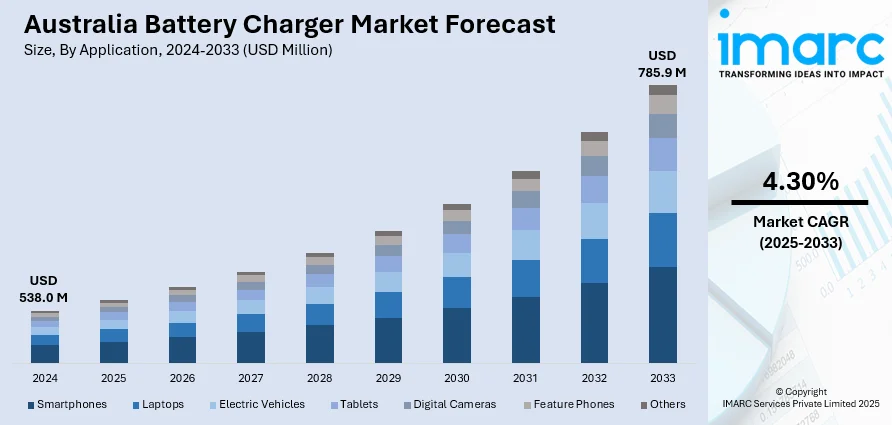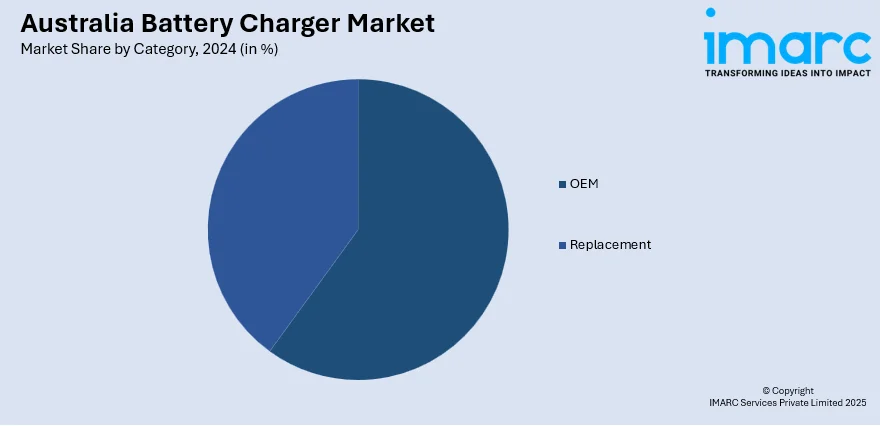
Australia Battery Charger Market Size, Share, Trends and Forecast by Application, Category, Product Type, and Region, 2025-2033
Australia Battery Charger Market Overview:
The Australia battery charger market size reached USD 538.0 Million in 2024. Looking forward, IMARC Group expects the market to reach USD 785.9 Million by 2033, exhibiting a growth rate (CAGR) of 4.30% during 2025-2033. The market is driven by increasing energy requirements in consumer electronics, electric mobility, and renewable energy storage, underpinned by changing technology trends and growing adoption in residential, commercial, and industrial segments.
|
Report Attribute
|
Key Statistics
|
|---|---|
|
Base Year
|
2024
|
|
Forecast Years
|
2025-2033
|
|
Historical Years
|
2019-2024
|
| Market Size in 2024 | USD 538.0 Million |
| Market Forecast in 2033 | USD 785.9 Million |
| Market Growth Rate 2025-2033 | 4.30% |
Australia Battery Charger Market Trends:
Growing Need for Electric Mobility Solutions
The growing uptake of electric mobility throughout Australia is having a major impact on the demand for cutting-edge battery charging technologies. As electric vehicles (EVs), scooters, and bicycles become increasingly popular in urban and semi-urban locations, battery chargers that enable high-efficiency, fast-charging are becoming essential. Institutions and consumers alike are looking for intelligent chargers that are compatible with different types of batteries and provide minimal energy loss. Investment by the public and private sector in electric vehicle (EV) infrastructure, such as the installation of EV charging points, is promoting innovation in the charger manufacturing industry. In addition, Australia's emphasis on cutting carbon emissions and clean transport is fueling the transition to electric mobility, thus propelling the charger industry. Australia battery charger market outlook depict a steep upward movement, showing long-term growth possibilities in residential, commercial, and industrial spaces related to electric mobility infrastructure and support systems. For instance, in October 2024, XCharge unveiled its Net Zero Series battery-integrated DC charger at Australia's National Bus & Coach Show, with 210kW output and 30–60kW input, improving rural EV charging efficiency.

To get more information of this market, Request Sample
Integration of Smart Charging Technologies
Incorporation of digital intelligence into battery charging systems is revolutionizing the market dynamics in Australia. Smart chargers with functionalities like Bluetooth connectivity, mobile app interface, voltage regulation by automation, and adaptive charging profiles are increasingly being favored by consumers. Such systems provide real-time monitoring, remote control, and energy optimization, making them extremely appropriate for contemporary use in smart homes and commercial buildings. Furthermore, innovations in Internet of Things (IoT) and cloud technologies are allowing predictive maintenance and usage analysis for battery chargers. With Australian consumers growing more energy-conscious and tech-savvy, smart charging solutions are likely to find wider acceptance. Governmental focus on digital innovation and smart infrastructure also helps to promote this trend. Australia battery charger growth, Australia battery charger market share highlight the increasing significance of software-based, efficient, and secure charging technologies in line with overall trends in automation and digital energy management.
Growth of Renewable Energy Storage Applications
Australia's solar and wind power renewable energy sector has driven growing demand for battery storage systems, hence the demand for effective battery chargers. For example, in July 2024, Australian firm Elumina will launch its $20 million community lithium battery and EV charger factory on the Gold Coast. The plant will make 300 EV chargers a year, supporting Australia's clean energy future and improving electric vehicle infrastructure. Furthermore, in hybrid energy systems and off-grid energy systems, battery chargers play a vital part in ensuring a steady availability of power. With more consumers and businesses embracing solar panels and energy storage batteries, chargers compatible with lithium-ion and lead-acid batteries are fast becoming a necessity. The emphasis is on chargers with high energy conversion efficiency, multi-stage charging, and overcharge protection, for longevity and performance. This trend is supported by government incentives for the installation of renewable energy and a national initiative toward sustainable energy independence. Australia battery chargers market growth is highly determined by trends in green energy technology, as there is a synergy between conservation goals and innovation in energy storage and charging equipment.
Australia Battery Charger Market Segmentation:
IMARC Group provides an analysis of the key trends in each segment of the market, along with forecasts at the region level for 2025-2033. Our report has categorized the market based on application, category, and product type.
Application Insights:
- Smartphones
- Laptops
- Electric Vehicles
- Tablets
- Digital Cameras
- Feature Phones
- Others
The report has provided a detailed breakup and analysis of the market based on the application. This includes smartphones, laptops, electric vehicles, tablets, digital cameras, feature phones, and others.
Category Insights:

- OEM
- Replacement
A detailed breakup and analysis of the market based on the category have also been provided in the report. This includes OEM, and replacement.
Product Type Insights:
- Wired
- Wireless
The report has provided a detailed breakup and analysis of the market based on the product type. This includes wired, and wireless.
Regional Insights:
- Australia Capital Territory & New South Wales
- Victoria & Tasmania
- Queensland
- Northern Territory & Southern Australia
- Western Australia
The report has also provided a comprehensive analysis of all the major regional markets, which include Australia Capital Territory & New South Wales, Victoria & Tasmania, Queensland, Northern Territory & Southern Australia, and Western Australia.
Competitive Landscape:
The market research report has also provided a comprehensive analysis of the competitive landscape. Competitive analysis such as market structure, key player positioning, top winning strategies, competitive dashboard, and company evaluation quadrant has been covered in the report. Also, detailed profiles of all major companies have been provided.
Australia Battery Charger Market News:
- In April 2025, Supercharge Australia launched its first Incubator program to help lithium battery startups. The 2025 cohort targets innovation in battery chemistry, recycling, energy storage, and electrified mobility, boosting Australia's innovation capacity and meeting national energy objectives and funding programs.
- In March 2025, MSI unveiled two electric vehicle (EV) chargers in Australia, namely the MSI EZgo Portable Charger and the MSI EV Series. These solutions complement infrastructure shortfalls in the midst of increased EV uptake across both urban and rural regions. The chargers meet Australia's net-zero ambition and government aspirations for cleaner transport.
Australia Battery Charger Market Report Coverage:
| Report Features | Details |
|---|---|
| Base Year of the Analysis | 2024 |
| Historical Period | 2019-2024 |
| Forecast Period | 2025-2033 |
| Units | USD Million |
| Scope of the Report |
Exploration of Historical Trends and Market Outlook, Industry Catalysts and Challenges, Segment-Wise Historical and Future Market Assessment:
|
| Applications Covered | Smartphones, Laptops, Electric Vehicles, Tablets, Digital Cameras, Feature Phones, Others |
| Categories Covered | OEM, Replacement |
| Product Types Covered | Wired, Wireless |
| Regions Covered | Australia Capital Territory & New South Wales, Victoria & Tasmania, Queensland, Northern Territory & Southern Australia, Western Australia |
| Customization Scope | 10% Free Customization |
| Post-Sale Analyst Support | 10-12 Weeks |
| Delivery Format | PDF and Excel through Email (We can also provide the editable version of the report in PPT/Word format on special request) |
Key Questions Answered in This Report:
- How has the Australia battery charger market performed so far and how will it perform in the coming years?
- What is the breakup of the Australia battery charger market on the basis of application?
- What is the breakup of the Australia battery charger market on the basis of category?
- What is the breakup of the Australia battery charger market on the basis of product type?
- What is the breakup of the Australia battery charger market on the basis of region?
- What are the various stages in the value chain of the Australia battery charger market?
- What are the key driving factors and challenges in the Australia battery charger?
- What is the structure of the Australia battery charger market and who are the key players?
- What is the degree of competition in the Australia battery charger market?
Key Benefits for Stakeholders:
- IMARC’s industry report offers a comprehensive quantitative analysis of various market segments, historical and current market trends, market forecasts, and dynamics of the Australia battery charger market from 2019-2033.
- The research report provides the latest information on the market drivers, challenges, and opportunities in the Australia battery charger market.
- Porter's five forces analysis assist stakeholders in assessing the impact of new entrants, competitive rivalry, supplier power, buyer power, and the threat of substitution. It helps stakeholders to analyze the level of competition within the Australia battery charger industry and its attractiveness.
- Competitive landscape allows stakeholders to understand their competitive environment and provides an insight into the current positions of key players in the market.
Need more help?
- Speak to our experienced analysts for insights on the current market scenarios.
- Include additional segments and countries to customize the report as per your requirement.
- Gain an unparalleled competitive advantage in your domain by understanding how to utilize the report and positively impacting your operations and revenue.
- For further assistance, please connect with our analysts.
 Request Customization
Request Customization
 Speak to an Analyst
Speak to an Analyst
 Request Brochure
Request Brochure
 Inquire Before Buying
Inquire Before Buying




.webp)




.webp)












